Key takeaways:
- Collaboration between artists and designers enhances creativity and innovation, leading to impactful outcomes.
- Setting clear objectives fosters accountability, focus, and a shared vision, preventing confusion in projects.
- Constructive feedback should prioritize a supportive tone, specificity, and timely delivery to encourage growth and improvement.
- Celebrating successes, big or small, strengthens team cohesion and motivation while acknowledging individual contributions.
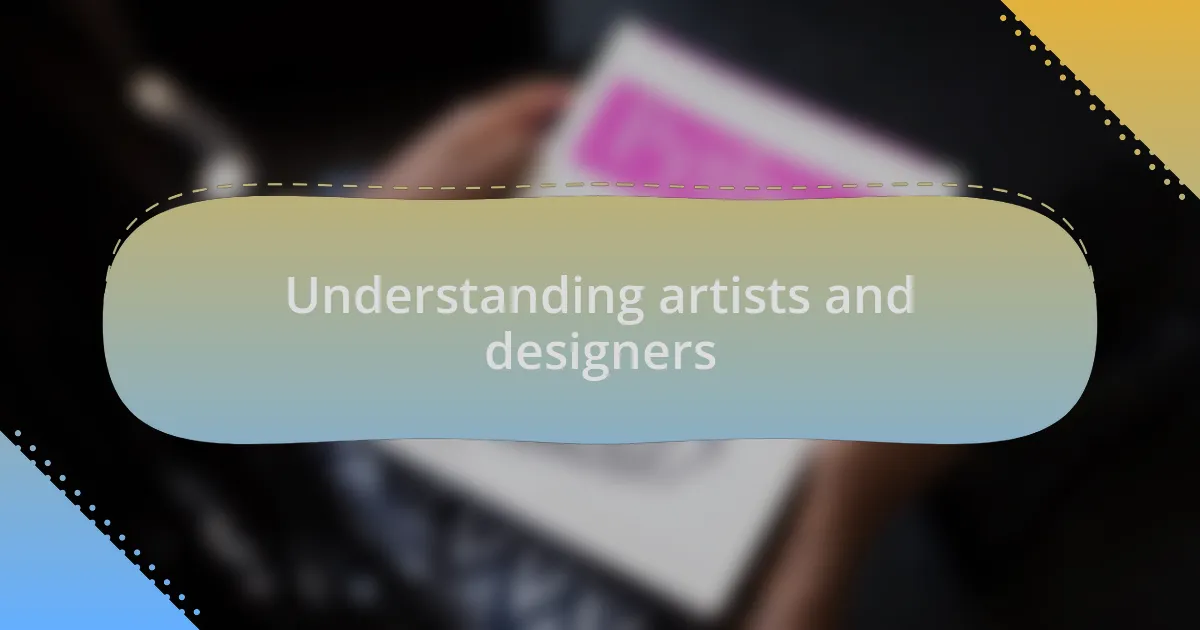
Understanding artists and designers
Artists and designers often operate with a unique blend of creativity and technical skill that can be fascinating to witness. I remember my first collaboration with an illustrator who brought my coding concepts to life in ways I could never have imagined. It made me realize how their perspective can transform a rigid framework into a vibrant visual experience—talk about a lightbulb moment!
Understanding their motivations is just as vital. Artists and designers typically seek to convey emotions and narratives through their work, which can be quite different from the logical, structured approach of programming. When I engage with creative professionals, I often ask them about their inspiration, and it’s enlightening to hear how their life experiences shape their art. Have you noticed how a personal story can add so much depth to a project?
It’s essential to foster an environment that encourages open communication. I’ve found that brainstorming sessions where artists and designers feel free to express their ideas lead to the most innovative outcomes. When they share their thoughts, it often sparks concepts I hadn’t considered. This collaborative synergy can be magical—what’s better than combining creativity with functionality?
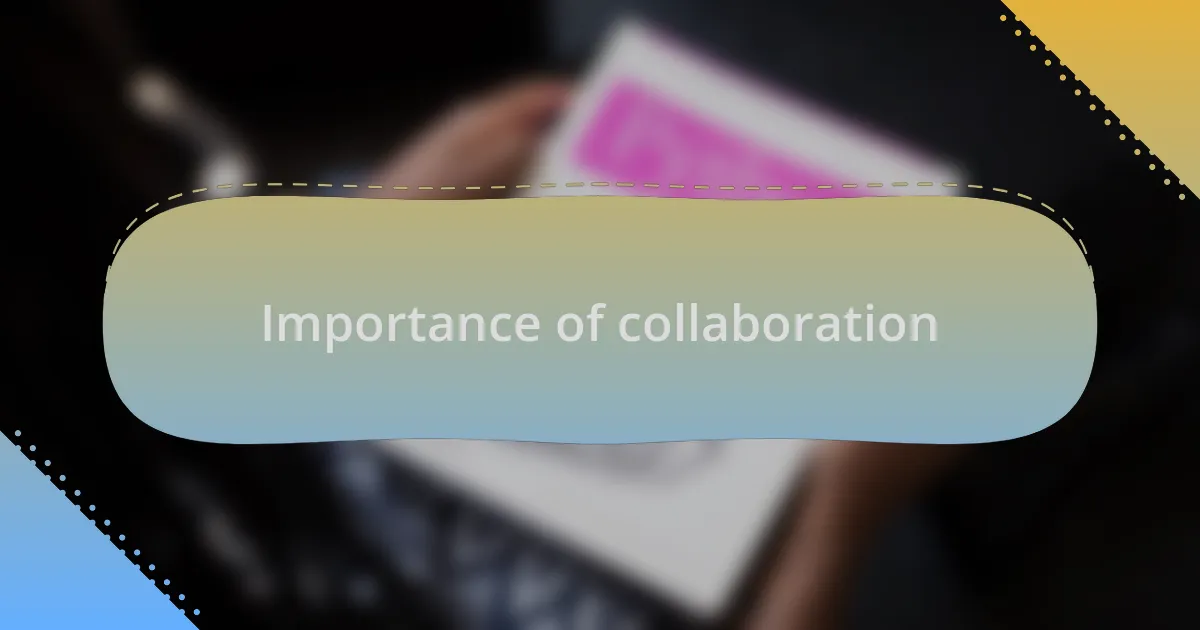
Importance of collaboration
Collaboration is like the secret ingredient that elevates a project from good to extraordinary. I once partnered with a graphic designer on an interactive web application. Watching how she interpreted my technical specifications into engaging visuals was a revelation. It made me realize that when we combine our distinct skill sets, we don’t just create; we innovate.
The interplay of ideas during collaboration fosters an environment ripe for breakthroughs. I vividly recall a tense moment during a project meeting where we hit a creative block. By encouraging each other to think outside the box, we stumbled upon a concept that not only met the objective but also resonated deeply with users. It was a reminder that our diverse backgrounds enrich our work, pushing us to explore uncharted territories.
Ultimately, collaboration isn’t just about efficiency; it’s about connection. I cherish those moments of shared enthusiasm with fellow creatives, where our collective energy transforms into something tangible and impactful. Have you experienced that rush of excitement when an idea takes flight through teamwork? It’s a reminder that together, we can achieve far more than we could alone.
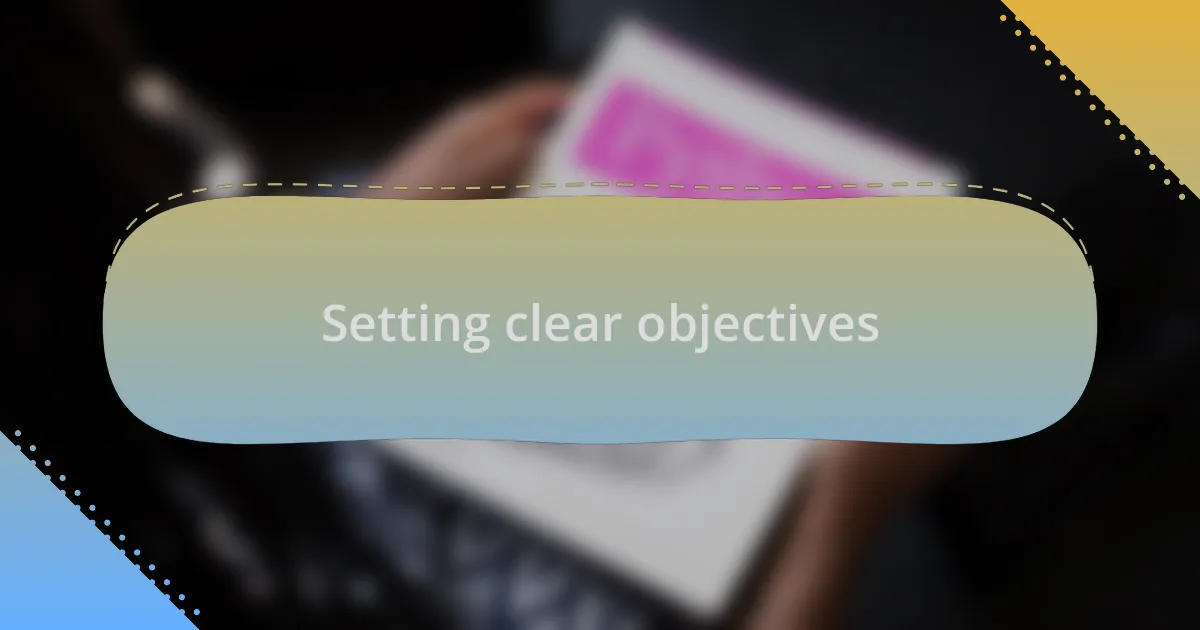
Setting clear objectives
Setting clear objectives is crucial for a successful collaboration with artists and designers. I remember a project where we started without a defined target, and it quickly turned chaotic. Each of us had our own vision, leading to misunderstandings and wasted effort. It became clear that without a shared goal, creativity could easily spiral into confusion.
Once we established specific objectives, everything shifted. I took the time to discuss with the designer what success looked like and sought her input on how we could measure it. I found that the clearer we were about our goals, the more focused and inspired we became. Have you ever noticed how a well-defined purpose can stir up motivation? It was as if a shared light bulb flicked on above our heads, guiding us forward.
Setting objectives also encourages accountability. With clear goals, I felt a growing responsibility to deliver my part, knowing my colleague was counting on me. This mutual commitment sparked a sense of partnership that I believe is essential for any creative project. Have you ever felt that camaraderie when working towards a common objective? It can make the journey not only productive but also deeply rewarding.
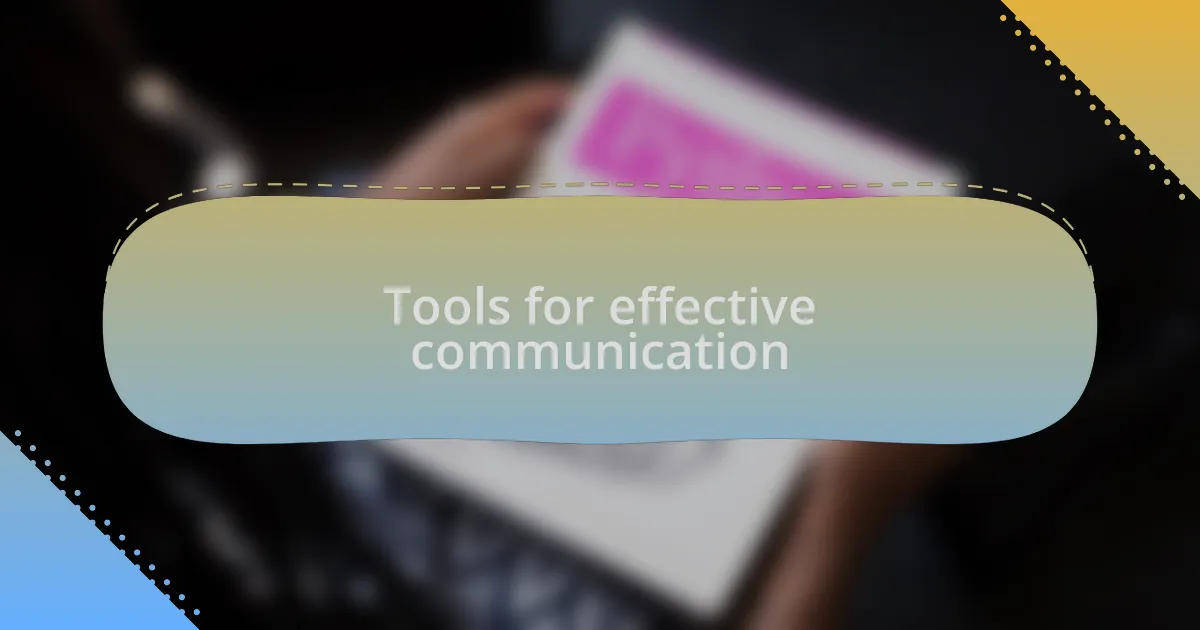
Tools for effective communication
Utilizing the right tools can significantly enhance communication with artists and designers. I often rely on platforms like Slack for real-time conversations. It reminds me of a time when we were finalizing a design. Instead of waiting for emails, quick chats allowed us to resolve misunderstandings immediately. Don’t you think that real-time feedback can save so much time and headaches?
Another great tool in my toolkit is Trello. It keeps our tasks organized and visible to everyone involved. Visual boards mean that artists and designers can track their progress at a glance. I remember a project where we could clearly see the flow of work, which helped us understand each other’s contributions better. Isn’t it satisfying to see how tasks move from “in progress” to “completed”?
Finally, I find that using shared documents like Google Docs encourages collaboration. It allows us to brainstorm and make edits in real-time, which feels like being in the same room together. There was a project where our ideas evolved fluidly thanks to this feature. Have you ever felt that collaborative energy when everyone can contribute simultaneously? There’s something uniquely exhilarating about building a project together in such an interactive manner.
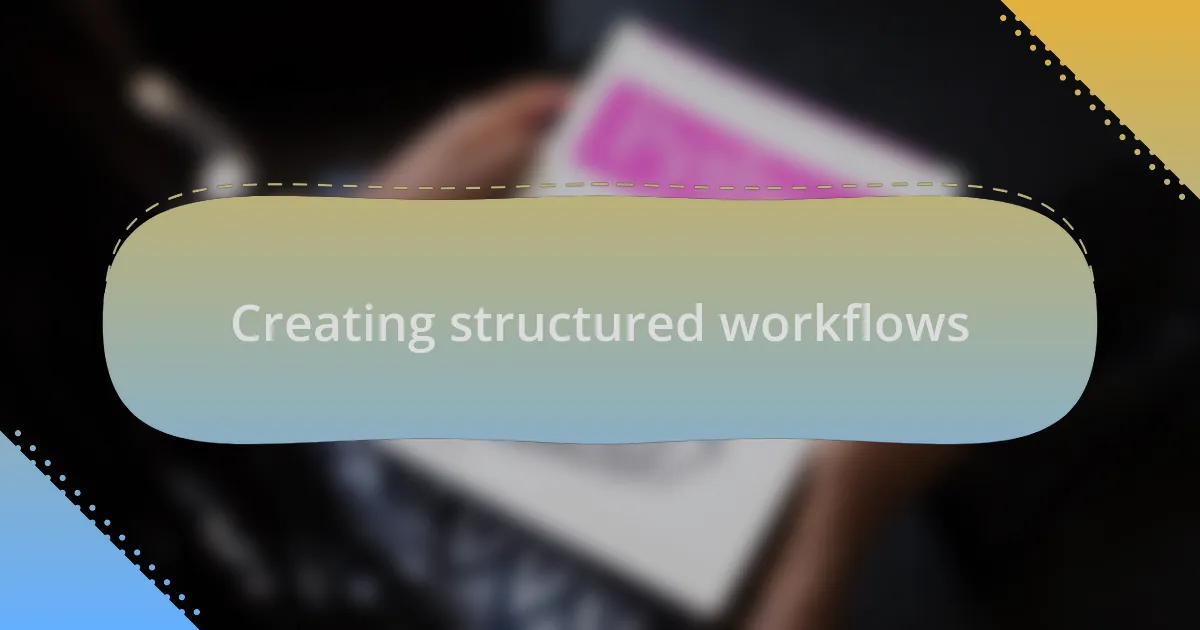
Creating structured workflows
Creating structured workflows is essential for seamless collaboration. I often start by breaking down projects into clear phases, which helps everyone understand their roles and deadlines. For instance, during a recent campaign, mapping out each step allowed us to visualize the journey from concept to completion, reducing anxiety over overlapping tasks. Have you ever felt overwhelmed because the project seemed too big? A phased approach can really alleviate that pressure.
Setting up regular check-ins is another technique I swear by. These scheduled meetings create a safe space for artists and designers to voice their thoughts and concerns. I recall a time when a quick weekly touchpoint revealed a potential design misalignment. By addressing it early, we transformed the workflow and avoided major setbacks. Isn’t it amazing how just a few minutes of conversation can clear up confusion and foster a productive environment?
Moreover, I find that utilizing templates for design submissions streamlines the process significantly. When I introduced a consistent format for asset delivery, I noticed improved clarity and efficiency. There was one instance where implementing a template cut our revision rounds in half. Have you experienced the frustration of receiving files that don’t meet the project specs? A simple template can make all the difference, ensuring everyone is on the same page right from the start.
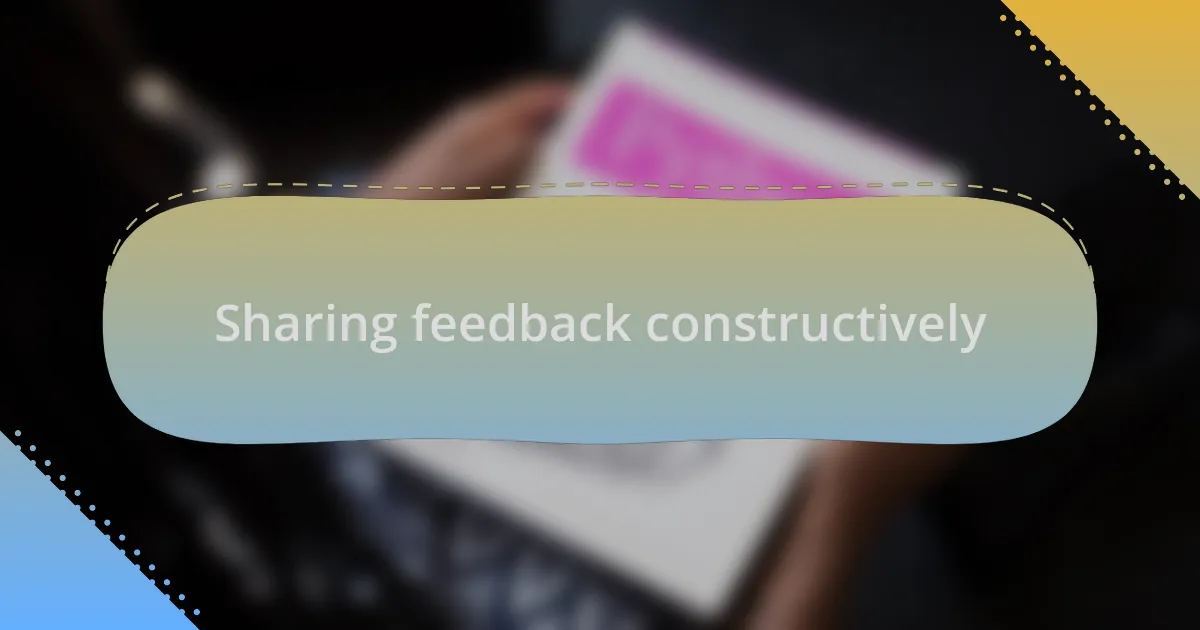
Sharing feedback constructively
When it comes to sharing feedback, I believe that the tone and delivery are just as important as the content itself. I prioritize a supportive atmosphere where constructive criticism is seen as an opportunity for growth rather than as a personal attack. There was a project where a designer struggled to incorporate my suggestions; instead of simply pointing out what wasn’t working, I focused on what they did well and then gently introduced my ideas. This approach not only made the designer feel valued but also fostered a collaborative spirit.
Being specific in my feedback is something I find crucial. For instance, instead of saying, “This needs work,” I might point out, “The color choice feels a bit too muted for our energetic brand.” This not only clarifies my perspective but also empowers the artist to explore alternatives. Have you ever received vague feedback that left you confused about how to improve? It can be disheartening, so I make a point to provide actionable steps that encourage creativity while guiding the project in the right direction.
Finally, I’ve found that timing plays a significant role in effective feedback. I like to wait until I’ve fully digested a piece before sharing my thoughts, ideally allowing some time for reflection. Once, after receiving a design that didn’t resonate with our goals immediately, I held off my feedback for a day. When I revisited it, my thoughts were clearer, and I was able to offer insights that were constructive and encouraging, ultimately leading to a stronger final product. Have you noticed how taking a moment can transform a rushed critique into a meaningful dialogue? It’s all about creating a partnership founded on mutual respect and understanding.
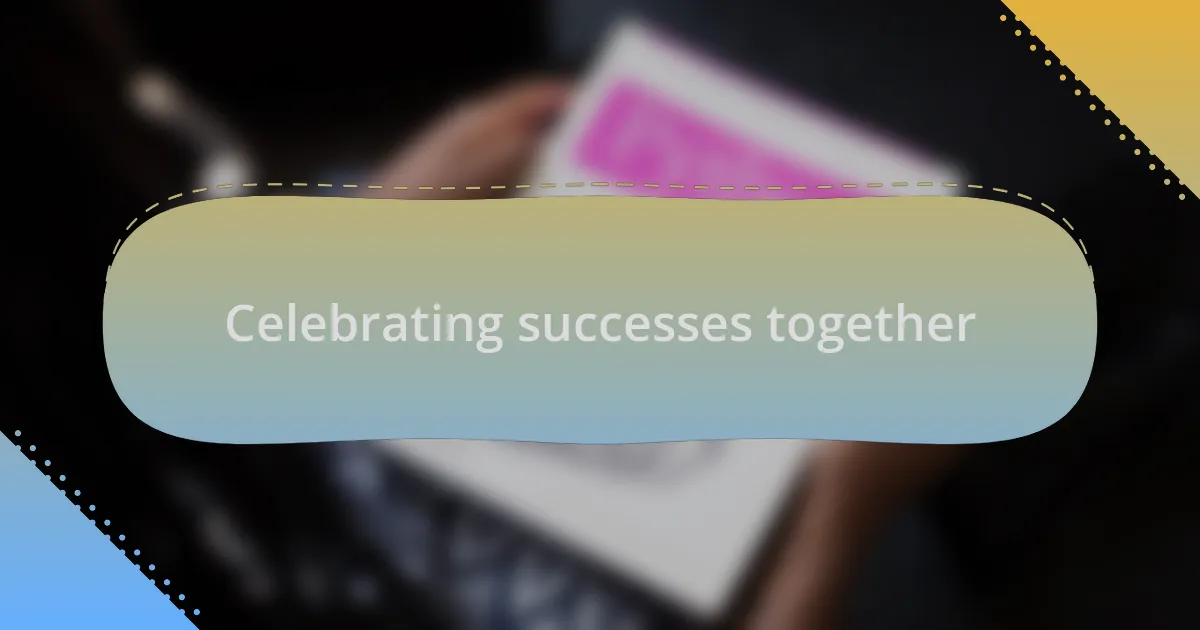
Celebrating successes together
Celebrating successes is an essential part of my collaboration with artists and designers. I remember a project where we hit a significant milestone, and instead of just moving on to the next task, I organized a small virtual gathering. It was a simple gesture, but acknowledging each contributor’s effort made everyone feel appreciated and motivated. How often do we take a moment to truly savor our achievements together?
In another instance, after launching a successful campaign that combined our artistic and coding efforts, I suggested creating a digital shout-out on our project management platform. Everyone shared their insights and experiences, and it felt like a collective pat on the back. Celebrating those wins made the team more cohesive. Don’t you find that little moments of joy can foster a better working environment and drive future successes?
I’ve learned that these celebrations don’t always need to be grand. Sometimes, a heartfelt email expressing gratitude can make someone’s day. I recall thanking a designer for her innovative approach that significantly elevated our project. Her smile, even through a screen, spoke volumes. Celebrating isn’t just about the big victories; it’s about recognizing the daily efforts that contribute to our collective success. How do you celebrate the small wins in your teams?